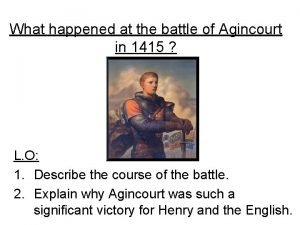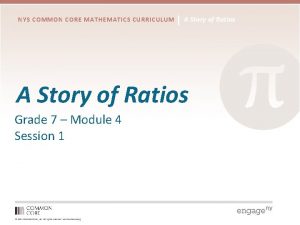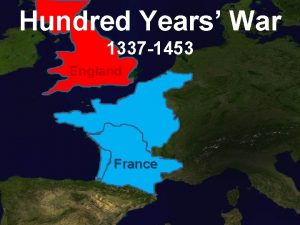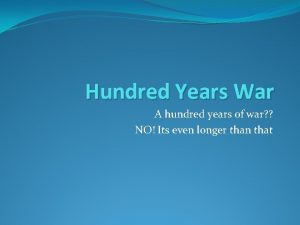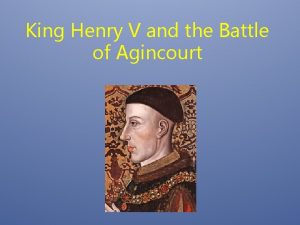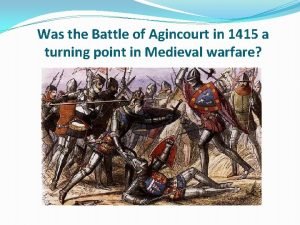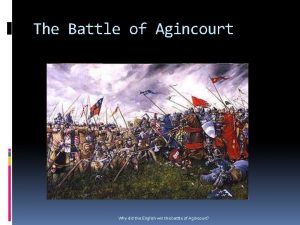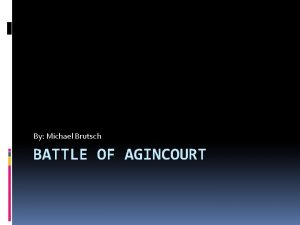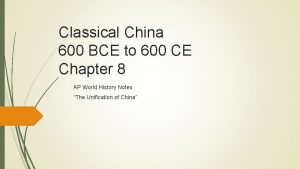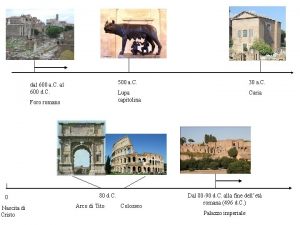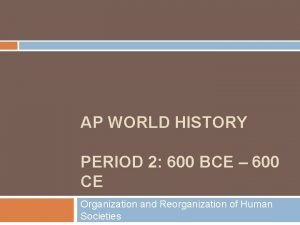Agincourt 600 Lesson 1 What caused the Hundred


































- Slides: 34

Agincourt 600 Lesson 1: What caused the Hundred Years War?

What on earth are these grown men doing in a field in France dressed like this?

Anglo-French relations 1066– 1337 Before the Conquest (pre-1066): Prior to the Norman Conquest of 1066, there were no armed conflicts between the kingdom of England the kingdom of France and England were subject to repeated Viking invasions, and their foreign preoccupations were primarily directed toward Scandinavia. William the Bastard took control of Normandy with the help of the French king. Although William's rule over Normandy had initially had the backing of King Henry I of France, William's success had soon created hostility, and in 1054 and 1057 King Henry had twice attacked Normandy.

Anglo-French relations 1066– 1337 Norman Conquest 1066: Dispute over the English throne after the death of Edward the Confessor led to the French-speaking Normans, who were of Viking stock, invading England under their Duke William, now known as William the Conqueror. His victory at the Battle of Hastings in 1066 meant he became king of England. The first Norman kings were also the dukes of Normandy, so relations were complicated between the countries. In addition, they were kings of England in their own right; England was not officially a province of France, nor a province of Normandy.

Anglo-French relations 1066– 1337 The Vexin War 1087: In 1087 Duke William of Normandy and King Philip of France partitioned between themselves the Vexin, a small but strategically important county on the middle Seine that controlled the traffic between Paris and Rouen, the French and Norman capitals. With this buffer state eliminated, Normandy and the king's royal demesne (the Île-de-France) now directly bordered on each other. In 1087, William responded to border raids conducted by Philip's soldiers by attacking the town of Mantes, during the sack of which he received an accidental injury that turned fatal.

Anglo-French relations 1066– 1337 Rebellion of 1088: Following William's death, his realms were split between his two sons (England to William Rufus, Normandy to Robert Curthose) and the Norman-French border war concluded. Factional strains between the Norman barons, faced with a double loyalty to William's two sons, created a brief civil war in which an attempt was made to force Rufus off the English throne. With the failure of the rebellion, England Normandy were clearly divided for the first time since 1066.

Anglo-French relations 1066– 1337 Wars in the Vexin and Maine 1097– 98: Robert Curthose left on crusade in 1096, and for the duration of his absence Rufus took over the administration of Normandy. Soon afterwards (1097) he attacked the Vexin and the next year the County of Maine. Rufus succeeded in defeating Maine, but the war in the Vexin ended inconclusively with a truce in 1098.

Anglo-French relations 1066– 1337 Anglo-Norman War 1101: Rufus was killed by an arrow shot while hunting (1100). His younger brother, Henry, took the throne. It had been expected to go to Robert Curthose, Duke of Normandy, but he was on crusade and did not return until a month after Rufus' death, by which time Henry was firmly in control of England, and his accession had been recognised by France's King Philip. Robert was able to reassert his control over Normandy. England Normandy were now in the hands of the two brothers. In July 1101, Robert launched an attack on England from Normandy. There he and Henry came to an agreement to accept the status quo of the territorial division.

Anglo-French relations 1066– 1337 Anglo-Norman War 1105– 06: Robert was not a strong ruler and with tension growing, Henry I invaded Normandy in the spring of 1105. This Anglo-Norman war was longer and more destructive. Henry had to return to England in the late summer, and it was not until the following summer that he was able to resume the conquest of Normandy. In the interim, Duke Robert took the opportunity to appeal to his liege lord, King Philip, but could obtain no aid from him. The fate of Robert and the duchy was sealed at the Battle of Tinchebray (1106). Robert was captured and imprisoned for the rest of his life. Henry was now, like his father, both king of England duke of Normandy.

Anglo-French relations 1066– 1337 Anglo-French War 1117– 20: In 1108, Philip of France died and was succeeded by his son Louis VI, who had already been involved in government for several years. Louis had initially been hostile to Robert Curthose, and friendly to Henry I; but with Henry's acquisition of Normandy, the old Norman. French rivalries re-emerged. From 1109 to 1113, clashes erupted in the Vexin; and in 1117 Louis made a pact with Baldwin VII of Flanders, Fulk V of Anjou and various rebellious Norman barons to overthrow Henry's rule in Normandy and replace him with William Clito, Curthose's son. By luck, diplomacy and warfare, however, Henry defeated his enemies.

Anglo-French relations 1066– 1337 The death of Henry I, 1135: Henry I tried to establish an alliance with Anjou by marrying his only legitimate son, William, to Fulk the Younger's daughter. However, William died in 1120. As a result, Henry then married his daughter Matilda to Geoffrey Plantagenet, count of Anjou; however, Henry's subjects had to accept Matilda's right to inherit the throne of England. In November 1135, Henry was dying; Matilda was in Maine while Stephen, Matilda's cousin and another contender for the English and Norman thrones, was in Boulogne. Stephen rushed to England upon the news of Henry's death and was crowned king of England in December 1135.

Anglo-French relations 1066– 1337 The Anarchy and the question of the Norman Succession (up to 1154): There now followed a period of civil war in England northern France known as the Anarchy. The king of France, now Louis VII, got involved on the side of Stephen but Matilda and her son Henry, count of Anjou, prevailed. An agreement was made between Matilda and Stephen that Henry would succeed to the throne of England after Stephen’s death. This happened in December 1154. Henry Count of Anjou became King Henry II of England.

Anglo-French relations 1066– 1337 The marriage of Henry and Eleanor of Aquitaine 1152: In March 1152, Louis VII and Eleanor of Aquitaine had their marriage annulled. The terms of the annulment left Eleanor as duchess of Aquitaine but still a vassal of Louis. She controlled a vast amount of land, now lost to the king of France personally. Eleanor was the most eligible lady in the realm. Eight weeks later she married Henry, count of Anjou. Thus Henry became duke of Aquitaine and Gascony and count of Poitiers.

Anglo-French relations 1066– 1337 Expansions of the Angevin Empire, 1154– 89: In the early years of his reign, Henry II claimed further lands and worked on the creation of a ring of vassal states as buffers. Scotland, Wales, Brittany were all claimed and Flanders became an ally.

Anglo-French relations 1066– 1337 Great Revolt 1173– 74: Henry controlled his dominions well, much to the annoyance of his barons, children and the king of France. Each had reasons to rebel against Henry and they came together in 1173. Battles were fought in France and England with Henry coming out on top. Often Henry’s sons sided with the French kings but when he died in 1189 Henry’s lands had not been diminished and he passed to Richard an empire stretching from Scotland to the Pyrenees.

Anglo-French relations 1066– 1337 The Third Crusade 1190– 92: Richard’s first action as king of England was to embark on the Third Crusade. Because he could not trust his French rival they went together. They followed the same route and arrived in Acre within a few weeks of each other. There they successfully brought the siege to a close but then Philip returned home leaving Richard in charge of a combined Anglo-Norman, French force. Once in France, Philip conspired with Richard’s younger brother, John, to stir up trouble among Richard’s barons in an effort to weaken the crusader.

Anglo-French relations 1066– 1337 Richard’s final years 1192– 99: Richard spent time in captivity in Germany after the Third Crusade; his high-and-mighty attitude to those of lesser importance than himself led to his capture and ransom by the Holy Roman Emperor. When he was released in 1194 he spent the next five years trying to regain the lands lost to Philip of France or his local barons. He died besieging a castle near Limoges in south-central France. His brother John inherited a slightly reduced empire.

Anglo-French relations 1066– 1337 Anglo-French war of 1202– 14: The Anglo-French War was a war between the kingdom of France and the kingdom of England. The war was mainly fought in Normandy, where John, king of England fought King Philip II of France for domination. The end of the war came at the decisive Battle of Bouvines, where Philip defeated England its allies. The only French dominion now in England’s control was Aquitaine (known in France as Guyenne), in the south-west.

Anglo-French relations 1066– 1337 First Barons War 1215– 16: While this conflict was between King John of England his barons it also included the French king and his son. The barons were so sick of their treatment under John that they made him sign the Magna Carta. Unfortunately for them John was on good terms with the pope and he was allowed to ignore its demands. This put the two sides at loggerheads. The barons called on the French for help and were willing to hand over England to Philip’s son, Louis. As it happened, John contracted dysentery and died a few weeks later. The barons swore loyalty to his son, Henry III.

Anglo-French relations 1066– 1337 The Provisions of Oxford 1258: Henry III inherited the throne as a minor and took control in 1227. His invasion of France in 1242 was a failure – he was not a good military leader. Henry’s policies of filling important positions within his government with Frenchmen rattled the barons and they rose against their king again. The result was the Provisions of Oxford. Another Barons War in 1264 saw Simon de Montfort, a powerful English baron, in control with Henry imprisoned. Edward, Henry’s son, traded himself for his father in gaol but escaped in 1266. He killed de Montfort in battle and went on crusade with Louis IX, king of France.

Anglo-French relations 1066– 1337 Edward I, 1272– 1307: Edward spent most of his reign trying to subjugate Wales and Scotland with campaigns in both those countries. A massive castle-building programme in Wales meant that much of the Crown’s income was spent in this way, leaving little time and money for expeditions into France.

Anglo-French relations 1066– 1337 Edward II, 1307– 27: Edward II was not as able a king as his father. He married the French king’s daughter, Isabella, when she was aged 12 (usual for the time) but was more interested in his male French lovers. He lost Scotland at the Battle of Bannockburn to Robert the Bruce. Edward faced further baronial strife and was deposed by the barons as his son took over as Edward III. One of the reasons for this was the loss of the Bordeaux region in France. Edward II was either killed by a red-hot poker being inserted into his anus or lived on in prison for a further ten years. Historical opinion is divided.

Anglo-French relations 1066– 1337 Edward III, 1327 onwards: Edward was young, 16, when he inherited the throne and his mother was powerful. Together with her lover Mortimer she ruled on Edward’s behalf until he is able to do something about it. Edward killed Mortimer in 1330 and placed his mother under house arrest. He was now king. Edward looked to assert his right to the French throne through his mother being the French king’s daughter – this started what is known as the Hundred Years War.

The Hundred Years War 1337– 1453 After years of English expansion within the British Isles kings once again turned their gaze to France and reasserted their claim to French lands. During the Hundred Years War England France battled for supremacy. Several of the most famous Anglo-French battles took place during the Hundred Years War: Crécy, Poitiers, Agincourt, Orléans, and Paris. Apart from setting national identities, the Hundred Years War is often cited as the root of the traditional rivalry and at times hatred between the two countries. During this era, the English lost their last territories in France, except Calais, which would remain in English hands for another 105 years, though the English monarchs continued to style themselves as Kings of France until 1800.

Strength of antagonism Hotspotometer 10 Marriage of Henry & Eleanor 1152: Eleanor was previously married to the king of France, their annulment and her marriage to his rival, Henry, increased tension because of the amount of land she brought to her new relationship. Norman Conquest 1066: As Normandy was a fief of France , relations between the two were complicated but still reasonably good. 0 1066 Date 1337


http: //www. globalsecurity. org/military/world/eur ope/uk-norman. htm Map 1: England Normandy after the Battle of Hastings

http: //conclarendon. blogspot. co. uk/2014/09/ang evin-empire. html Map 2: The Angevin Empire c. 1154– 99

http: //www. csun. edu/~sk 36711/WWW/engl 630/ maps. htm Map 3: The Angevin Empire 1154– 1220

https: //en. wikipedia. org/wiki/Crown_lands_of_Fra nce#/media/File: Territorial_Conquests_of_Philip_I I_of_France. png Map 4: Lands lost by King John and Henry III OR Map 4: Lands gained by King Philip of France

http: //www. nuttyhistory. com/100 -years-war. html Map 5: Hundred Years War c. 1337

http: //www. nuttyhistory. com/100 -years-war. html Map 6: Hundred Years War c. 1360

http: //www. nuttyhistory. com/100 -years-war. html Map 7: Hundred Years War c. 1429

http: //www. nuttyhistory. com/100 -years-war. html Map 8: Hundred Years War c. 1453
 What happened
What happened Trigonometri
Trigonometri Lesson 17 mixture problems
Lesson 17 mixture problems Hát kết hợp bộ gõ cơ thể
Hát kết hợp bộ gõ cơ thể Lp html
Lp html Bổ thể
Bổ thể Tỉ lệ cơ thể trẻ em
Tỉ lệ cơ thể trẻ em Gấu đi như thế nào
Gấu đi như thế nào Tư thế worm breton
Tư thế worm breton Chúa sống lại
Chúa sống lại Môn thể thao bắt đầu bằng chữ f
Môn thể thao bắt đầu bằng chữ f Thế nào là hệ số cao nhất
Thế nào là hệ số cao nhất Các châu lục và đại dương trên thế giới
Các châu lục và đại dương trên thế giới Công thức tiính động năng
Công thức tiính động năng Trời xanh đây là của chúng ta thể thơ
Trời xanh đây là của chúng ta thể thơ Mật thư anh em như thể tay chân
Mật thư anh em như thể tay chân Phép trừ bù
Phép trừ bù độ dài liên kết
độ dài liên kết Các châu lục và đại dương trên thế giới
Các châu lục và đại dương trên thế giới Thơ thất ngôn tứ tuyệt đường luật
Thơ thất ngôn tứ tuyệt đường luật Quá trình desamine hóa có thể tạo ra
Quá trình desamine hóa có thể tạo ra Một số thể thơ truyền thống
Một số thể thơ truyền thống Cái miệng xinh xinh thế chỉ nói điều hay thôi
Cái miệng xinh xinh thế chỉ nói điều hay thôi Vẽ hình chiếu vuông góc của vật thể sau
Vẽ hình chiếu vuông góc của vật thể sau Thế nào là sự mỏi cơ
Thế nào là sự mỏi cơ đặc điểm cơ thể của người tối cổ
đặc điểm cơ thể của người tối cổ Thế nào là giọng cùng tên?
Thế nào là giọng cùng tên? Vẽ hình chiếu đứng bằng cạnh của vật thể
Vẽ hình chiếu đứng bằng cạnh của vật thể Fecboak
Fecboak Thẻ vin
Thẻ vin đại từ thay thế
đại từ thay thế điện thế nghỉ
điện thế nghỉ Tư thế ngồi viết
Tư thế ngồi viết Diễn thế sinh thái là
Diễn thế sinh thái là Các loại đột biến cấu trúc nhiễm sắc thể
Các loại đột biến cấu trúc nhiễm sắc thể
